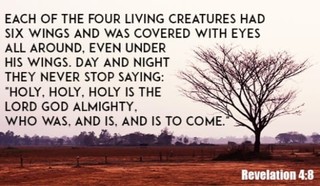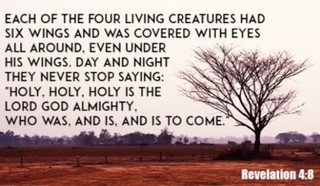- Recent Translations
- All Translations
Hisgalus 4
Share
Settings
Hisgalus 4 Commentary
Chapter 4
A vision of God, as on his glorious throne, around which were twenty-four elders and four living creatures. (1-8) Whose songs, and those of the holy angels, the apostle heard. (9-11)
Verses 1-8 After the Lord Jesus had instructed the apostle to write to the churches "the things that are," there was another vision. The apostle saw a throne set in heaven, an emblem of the universal dominion of Jehovah. He saw a glorious One upon the throne, not described by human features, so as to be represented by a likeness or image, but only by his surpassing brightness. These seem emblems of the excellence of the Divine nature, and of God's awful justice. The rainbow is a fit emblem of that covenant of promise which God has made with Christ, as the Head of the church, and with all his people in him. The prevailing colour was a pleasant green, showing the reviving and refreshing nature of the new covenant. Four-and-twenty seats around the throne, were filled with four-and-twenty elders, representing, probably, the whole church of God. Their sitting denotes honour, rest, and satisfaction; their sitting about the throne signifies nearness to God, the sight and enjoyment they have of him. They were clothed in white raiment; the imputed righteousness of the saints and their holiness: they had on their heads crowns of gold, signifying the glory they have with him. Lightnings and voices came from the throne; the awful declarations God makes to his church, of his sovereign will and pleasure. Seven lamps of fire were burning before the throne; the gifts, graces, and operations of the Spirit of God in the churches of Christ, dispensed according to the will and pleasure of Him who sits upon the throne. In the gospel church, the laver for purification is the blood of the Lord Jesus Christ, which cleanses from all sin. In this all must be washed, to be admitted into the gracious presence of God on earth, and his glorious presence in heaven. The apostle saw four living creatures, between the throne and the circle of the elders, standing between God and the people. These seem to signify the true ministers of the gospel, because of their place between God and the people. This also is shown by the description given, denoting wisdom, courage, diligence, and discretion, and the affections by which they mount up toward heaven.
Verses 9-11 All true believers wholly ascribe their redemption and conversion, their present privileges and future hopes, to the eternal and most holy God. Thus rise the for-ever harmonious, thankful songs of the redeemed in heaven. Would we on earth do like them, let our praises be constant, not interrupted; united, not divided; thankful, not cold and formal; humble, not self-confident.
Hisgalus 4 Commentaries
Chapter Summary
INTRODUCTION TO REVELATION 4
This chapter contains an account of the second vision John saw, as preparatory to the sealed book, and the opening of it, as the first vision was to the epistles to the seven churches. The preface to this vision, or the introduction to it, and preparation of John for it, are in Re 4:1,2, which declare the time of it, the position John was in, what he saw and heard, a call to him to come up, and the effect it had upon him; and then follows the vision itself, which is of a throne, described by the place where it was set, in heaven; and by him that sat upon it, Re 4:2, who was like to a jasper and a sardine stone; and by what was about it, first a rainbow of an emerald colour, Re 4:3, then four and twenty seats, with as many elders upon them, sitting clothed and crowned, Re 4:4, and by what went out from it, lightnings, thunderings, and voices; and by what were before it, seven burning lamps, which are the seven spirits of God, Re 4:5, and a sea of glass like crystal; and by what were between it all around, and the elders, four living creatures, described in general by their being full of eyes, before and behind, Re 4:6, in particular, the first by its likeness to a lion, the second by its likeness to a calf, the third by its likeness to a man, and the fourth by its likeness to a flying eagle, Re 4:7, and by what were common to them, first by their wings, of which they had each of them six; and by their eyes, they were full of within; and by their constant employment in celebrating the perfections of God, and in giving glory, honour, and thanks unto him, Re 4:8,9, at which time also the four and twenty elders appear in a worshipping posture, and give adoration to God; partly by deeds, casting their crowns before his throne; and partly by words, ascribing glory, honour, and power to him; giving a reason for it, taken from his creating all things for his pleasure, Re 4:10,11.

